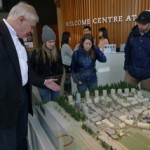When we flush the toilet at UBC, where does the sewage go? This question surfaced in a class discussion of PLAN 597: Planning for Water Resource Management (Prof. Honey-Rosés). After realizing that no one had the answer, the class decided to find out. Perhaps UBC practiced innovative sewage treatment as part of its sustainable strategy? And how did concerns over sustainable water management influence the new development plans on campus?
After several phone calls and email exhanges, we were pleased to learn that Joe Stott, Director of Campus Planning had offered to take our class for a tour of Wesbrook neighbourhood, a new mixed use development on the south part of campus.
The tour began on a sunny Friday afternoon at the Welcome Center where our group huddled around the intricate model of Wesbrook. The urban transformation was evident. Originally a site of fishing ponds and native flora, Wesbrook has quickly transforming into a miniature village filled with mid-rise housing, condos and a high street along the main drive. Particularly impressive, from an urban design standpoint, was the row housing to maintain streetscape, curved roads, and the zoning of mid-rise buildings to emphasize scale and walkability. The class appreciated the extensive greenway network, making streets safer for pedestrians and cyclists, as well as the stormwater drainage channels that emulate a natural creek. After our discussion around the model, Joe graciously guided us through the neighbourhood to take a closer look at the distinct water features.
As we walked along the newly designed streets, accompanied by the sound of rushing water, Joe described the stormwater challenges. First, there is the problem of cliff erosion along Wreck Beach, which campus helped mitigate by building a large underground water retention basin. Another problem is the stormwater runoff through Booming Ground Creek, the area where South UBC drains through, and the risks of potential damage. As a solution, Planning worked with the community to create a system of drainage channels in Wesbrook that captures excess water from rooftops which is then led through a series of channels into a pond in Smith Park. From there the excess water is held in detention ponds and released at a controlled rate to prevent damage to surrounding areas. As a practical solution, the drainage channels are as scenic as they are functional. We also learned that the drinking water comes from the Greater Vancouver Regional District. Being curious about waste management, we were surprised to learn that UBC is in partnership with Metro Vancouver for their waste disposal and like other municipalities sends its wastes to the Vancouver Transfer Station. As the campus undergoes numerous efforts to encourage waste reduction and coordinate recycling and composting it will be interesting to see how waste management adapts to the projected growth of campus expansion in the future.
As an unincorporated area outside of the City of Vancouver, Wesbrook enjoys the unique benefits of occupying a space on the University Endowment Lands (UEL) without a municipal governing body. In a sense, this has afforded campus planning a great deal of autonomy when implementing their building code standards and development directions. According to Mr. Stott, campus planning was able to cherry-pick ideas from surrounding municipalities in the GVRD to transform Wesbrook into an attractive water-embracing oasis that includes both market and rental housing with significant allocations made for staff and students. In fact, while walking around the neighbourhood it is difficult to differentiate market from rental, a great testament to the care taken in each project. UBC’s long-term goals and aspirations of Wesbrook as a live-work-play hub for professors, students and the growing population of market owners is exciting and forward thinking. Yet, there remain concerns around affordability, governance and compliance with developers to adhere to the green building code initiatives, which no doubt will present obstacles in the future. As future planners, we saw an opportunity to work with the University to learn from and hope to engage more with the Campus and Community Planning Office.
